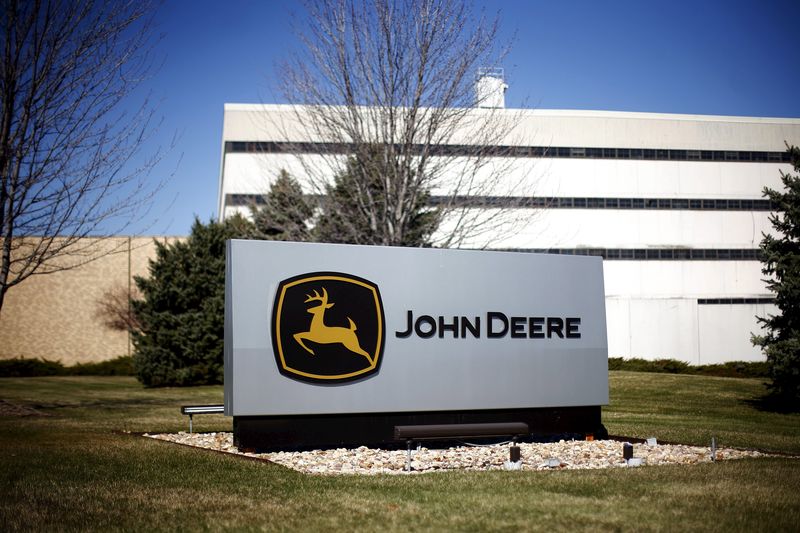This post was originally published on this site
https://i-invdn-com.akamaized.net/news/LYNXMPEBBM0WS_M.jpg © Reuters. Deere’s Dour Outlook Tests Faith in Manufacturing Rebound
© Reuters. Deere’s Dour Outlook Tests Faith in Manufacturing Rebound(Bloomberg Opinion) — Deere & Co. results show the trouble with reading the economic tea leaves.
The maker of tractors and construction equipment slumped on Wednesday after announcing a depressed outlook for fiscal 2020 that caught investors off guard. Deere expects net income to be no higher than $3.1 billion next year, a decline relative to 2019 and well below the $3.46 billion analysts had been modeling. Here was investors’ response:
The root of the disappointment is Deere’s expectation that global agricultural and turf equipment sales will slump 5% to 10% next year. Heading into earnings, there was optimism that Deere might even see growth in that division, should the prospect of a trade deal and the Trump administration’s plans to pump financial support into the farming industry incentivize growers to finally swap out aging equipment. Indeed, data released by the Commerce Department on Wednesday showed that capital spending excluding aircraft increased in October by the most since the start of the year, adding credence to the idea that the slowdown in industrial growth is bottoming out.
With the trade war still lingering in the background, though, it appears Deere CEO John May isn’t banking on much of anything. That seems the prudent path to take. For one, May only just ascended to the CEO role this month and is likely disinclined to set goals he can’t guarantee in such an uncertain environment (3M (NYSE:) Co.’s Michael Roman, who’s cut guidance an absurd number of times in his short tenure, should probably take note). But even CEOs who have been around for a while would have trouble predicting how their customers will act six to nine months down the road. This industrial downturn has been different from others in that it’s not a function of supply-and-demand dynamics but of political uncertainty. Manufacturing data can naturally be lumpy given the volatile timing of big projects, or in the case of this year, the General Motors Co (NYSE:). labor strike. But the unpredictable nature of trade negotiations makes the trajectory of any recovery particularly difficult to predict.
The tariffs that China and the U.S. have levied against each other have made inventory management something more akin to an Olympic sport as companies try to get ahead of the levies but also guard against getting stuck with a bunch of unwanted goods. That challenge was reflected in Deere’s outlook. Looking at the broader market, Deere expects demand for agricultural equipment to drop 5% in the U.S. and Canada, while the European, South American and Asian markets are seen remaining flat. That’s not as severe as Deere’s forecast for its own business, a dynamic which Jefferies analyst Stephen Volkmann says likely reflects an expectation that dealers are still sitting on too much inventory and will work through that before placing new orders. An upwardly revised GDP figure released Wednesday of 2.1% for the third quarter also reflected inventory accumulation.
Point being, no one really knows anything, and everyone is afraid of moving in the wrong direction. One reason Deere’s lackluster guidance hit its stock particularly hard is that the forecast wasn’t accompanied by much detail on restructuring that the company had previously indicated would be forthcoming. The company will implement a voluntary separation program for some employees that should save about $150 million annually when combined with 2019 cost-cutting efforts. If the outlook is really as bad as Deere claims, though, you would think we would see something more substantive on cost cuts. But to get aggressive with restructuring, Deere also has to be confident that this market isn’t going to turn around on a dime if there is in fact a legitimate trade deal, lest it end up short-staffed.
The Trump administration is quickly running out of ways to describe the trade talks and proximity to a “phase-one” agreement. One day we were down to the “short strokes,” the next we’re in the rather morbid sounding “final throes.” But while investors are more than happy to price in those words as a done deal, CEOs are thinking differently. Deere’s downbeat guidance follows similar outlooks from Caterpillar Inc (NYSE:). and Emerson (NYSE:) Electric Co. that in certain lights could be construed as conservative. Or they might just be accurate.
Fusion Media or anyone involved with Fusion Media will not accept any liability for loss or damage as a result of reliance on the information including data, quotes, charts and buy/sell signals contained within this website. Please be fully informed regarding the risks and costs associated with trading the financial markets, it is one of the riskiest investment forms possible.

